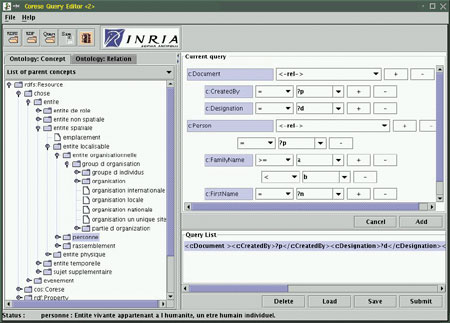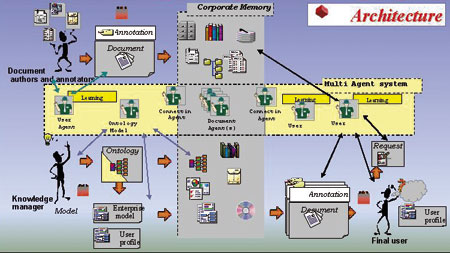 This issue in pdf Archive: |
|
|||||
Corporate Semantic Websby Rose Dieng-Kuntz The ACACIA multidisciplinary team at INRIA-Sophia-Antipolis is working towards offering methodological and software support (ie models, methods and tools) for knowledge management (ie for building, managing, distributing and evaluating a corporate memory) for an organisation or community. This corporate memory can be materialised in a 'Corporate Semantic Web' consisting of ontologies, resources (such as documents or persons) and annotations, possibly with modelling of multiple viewpoints. We make an analogy between the corporate memory and the open World Wide Web: both are heterogeneous and distributed information landscapes and share the same problem of information retrieval relevance. In contrast, however, corporate memory has a context, an infrastructure and a scope limited to the organisation in question. As research on the Semantic Web aims to make the semantic contents of the Web interpretable by software, we propose to materialise a corporate memory as a 'Corporate Semantic Web', constituted of ontologies, resources (ie documents or humans) and semantic annotations on these resources (ie on the document contents or the person features/competences), where these annotations rely on the ontologies. We are studying the main research problems raised by such a 'Corporate Semantic Web':
Ontology and Annotation Construction
We used this hybrid method to build the O'CoMMA ontology (see below), dedicated to organisational memory and to scenarios such as newcomer insertion or technological monitoring. As several corporate information sources can help to build an ontology (eg human experts, textual or multimedia documents, databases with possibly textual data), the SAMOVAR method and system rely on partly automated construction and enrichment of ontologies and of annotations from heterogeneous information sources, by applying natural language processing tools on textual sources. SAMOVAR was applied to project memory in the automobile industry. Ontology and Annotation Representation In order to palliate some limitations of RDFS for ontology representation, we proposed DRDFS, an extension of RDFS which enables the expression of explicit definitions of concepts and of relations, as well as contextual knowledge. We also proposed the GDL language, a description logic inspired by conceptual graphs. CORESE Semantic Search Engine The CoMMA project: Corporate Memory Management through Agents We have also developed algorithms for learning ontologies incrementally from RDF annotations on (corporate) Web resources. This method can be used to build classes of documents automatically from their annotations. Two scenarios were studied: the insertion of new employees and technological monitoring. The CoMMA system, implemented in JAVA on the FIPA-compliant multi-agent platform JADE, integrates our search engine CORESE.
Applications and Further Work In further work we intend to study a corporate memory distributed among several cooperating companies or communities. This memory will be materialised through a Semantic Web operating between organisations or communities, possibly handling multiple ontologies and multiple viewpoints and possibly requiring Web mining, for scenarios including project memory, technological monitoring and skills management. The work described above was carried out by Olivier Corby, Alexandre Delteil, Rose Dieng-Kuntz, Catherine Faron-Zucker, Fabien Gandon, Alain Giboin, Joanna Golebiowska and Carolina Medina-Ramirez. Links: Please contact: |
|||||



